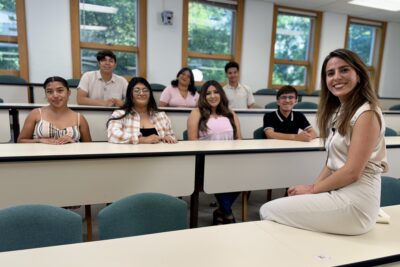In a month’s time, the Recreation-Fitness Center will be the first building on Goshen College Campus to use solar-powered water heating.
Faculty advisors John Buschert and Glenn Gilbert had, for several years, pondered utilizing solar-powered energy on campus. But it was not until last year that the plan began to take shape.
And that shape was tubular.
Rows of 25 tubes will lie parallel to make up eight 7-foot solar panel racks that will power the RFC’s daily hot-water use. A layer of glass surrounds a smaller tube that has a special coating that collects heat from the sun.
The racks will be elevated over the heat storage tank currently under construction. When the tank is finished, it will contain 4,000 gallons of heated water, 800 of which will be a reserve for the RFC’s daily consumption.
“Our hope is to heat more water than we need each day,” said Buschert. “See, most hot water systems are supplementary, meaning when you need more energy on a cloudy day, you simply use traditional heaters. Our system is much less common.”
This heat generator, instead of relying on conventional energy, will produce enough hot water to be separated, stored and used for days without sun.
The idea is that the solar-powered heater will produce water for “a good portion—not all, but a good portion—of the year,” Buschert said.
Though the project was initiated because it will eventually conserve energy and resources, the process was not easy or inexpensive.
“The one thing about this project is that, as cool as it is, it doesn’t pay itself off quickly,” Gilbert said. “We needed grants and initiative, student initiative, to keep working.”
Luckily, Gilbert and Buschert were able to find students willing to take such initiative. Isaac Yoder-Shrock and Andrew Glick have both volunteered their time to carefully calculate designs, track down funding and, as of three weeks ago, begin construction. Other students who have more recently become involved are Micah Miller-Eshleman and Micah Wiebe-Powell. Another important member of the solar development team is staff member Steve Shantz, systems operations technician.
“I’m into alternative energy,” said Glick, a sophomore physics major. “John (Buschert) recommended we get involved, so I volunteered.”
Once Glick, Yoder-Shrock and their faculty advisers and other student volunteers finalized plans for the most energy efficient system, expected funding was estimated at $40,000. The group approached the Ecological Steward Committee, the campus group concerned with issues of sustainable energy and ecology, who provided $20,000. The remaining half has been paid off through fund-raising and private donation.
The future of a solar-powered campus remains indeterminate. “But you know,” said Buschert, “everyone has hopes.”


